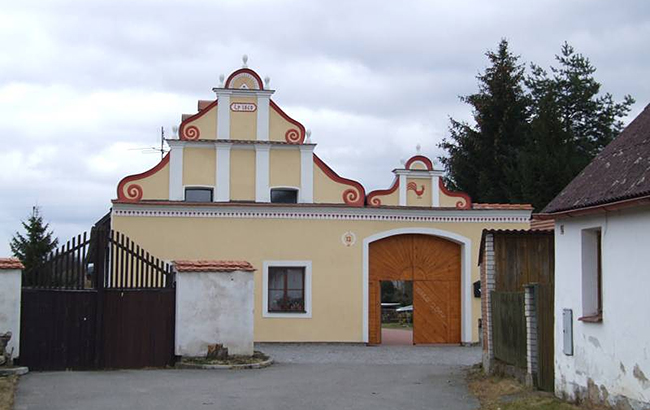
Mason master Jakub Bursa was one of the creators of South Bohemian folk baroque
 |
| Rural estate in Bušanovice (1860). photo: Jana Štorková, Heritage Catalog NPU |
Prague – South Bohemian rural baroque is a term recognized even beyond the borders of the Czech Republic. Picturesque farms from the 19th century adorn the squares of many villages. One of the creators of this original style was the mason master Jakub Bursa. He was captivated by baroque but transformed it entirely in his own way. Bursa's works can be found mainly in the Prachatice and Strakonice regions, where he created grand and distinctly shaped gables. The 140th anniversary of the death of this folk builder will be celebrated on August 19.
Although Bursa was not a trained architect, he had ideas and the desire to realize them. In addition to bulbous columns, he used bass-like shaped windows and shells at the top of the gable. He is also characterized by volutes (spiral motifs) or semi-circular tympanons (decorated areas in the gable) supported by pilasters (false columns). Bursa's works exhibit sculptural talent and a penchant for stucco reliefs—both figurative and ornamental. He particularly favored trees with cones.
Bursa often decorated his buildings with various texts, for instance, in today's language: "Today, it is served for money, tomorrow for free". He did not measure out the inscriptions, just laid them out by eye or wrote them with a stick in the sand in front of the object. If the text did not fit at the end, he simply crammed in the letters. In this respect, the grammatical errors in Bursa's texts are amusing. He paid little attention to spelling, did not use diacritics, and commonly wrote double "W". Once a letter was shaped, he did not correct it.
Among his most famous works, some of which are protected as technical monuments, are the buildings in Libotyne in the Prachatice region: a chapel with a bell tower, a forge, and a house. The artistically most mature works with paintings, sayings, and stucco reliefs include the gables in Dolní Nakvasovice in the Prachatice region or the gable extensions above the entrances in Předslavice in the Strakonice region. The gables from the early period of Bursa's work in Jiřetice in the Strakonice region are protected as monuments. Other constructions by him include an inn in Miloňovice (Strakonice region) or a house in Bušanovice (Prachatice region).
Bursa was born on July 21, 1813, in Dolní Nakvasovice in the Prachatice region. He was one of eight children from a masonry family; both his father and one of his brothers practiced the trade. According to researchers, he was not a particularly diligent student, and his school attendance was poor. However, he was the eldest son and often had to help on the farm or look after his siblings. In 1831, the skilled and inventive Bursa was accepted into the masonry guild in Vlachovo Březí. He then set off into the world to gain experience.
Bursa was said to have a cheerful nature; he loved company, good food, and drink. However, he was not very good with money. Although he built primarily for wealthy farmers, he squandered most of his earnings. Fortune did not favor him in his family life either. He married three times, but all his wives died. He fathered a total of 13 children from his relationships. Five of them died in early childhood, and two others in adulthood.
Bursa ceased building his gables—called bursovky—for unclear reasons around 1862. He died alone and ill on August 19, 1884, at the age of 71 in a poorhouse in Vlachovo Březí.
The term rural baroque refers to a unique village architecture that incorporates baroque, rococo, and neoclassical elements in the South Bohemian countryside. These buildings are most commonly found in the central part of South Bohemia, traditionally called Blata, roughly between Netolice in the west and Kardašova Řečice in the east. Many farms have preserved their original arrangement and decoration. The most famous are Holašovice in the Czech Budějovice region, protected by UNESCO since 1998.
The English translation is powered by AI tool. Switch to Czech to view the original text source.











